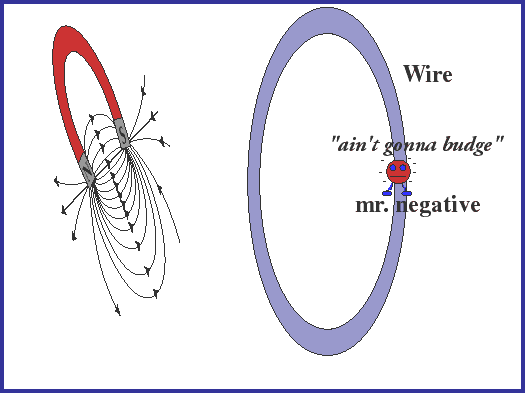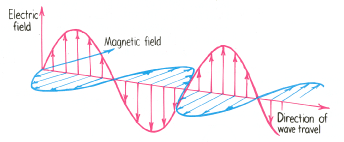![]()
![]()
![]()
Average score for the exam was 21 points out of 32, or about 66%. Here is what the grades distribution looks like:
- Let's go through some problems and figure out the answers.
- Link exam results and answers.
![]()
![]() Magnetism from electric current.
Magnetism from electric current.
Christian Orsted observed in 1819 that a wire carrying a current (charge in motion) produces a magnetic field. This is how electromagnets work- current flows through a coil of wire, the optimal arrangement of wire for producing a strong magnetic field. One can observe current producing a magnetic field by placing a compass next to a wire carrying current:
One can reinforce the current-carrying wires magnetic field by winding it into a coil. This gives a stronger magnetic field. The field lines from this coil resemble those of a bar magnet.
This is perhaps better demonstrated with the fabulous jumping wire demonstration.
Electric Motors
Magnets can exert forces on one another. One can construct a permanent magnet as shown below. The magnetic field lines connect the magnet's "south" pole to its north.
Now place a current-carrying coil of wire so that its magnetic field interacts with the permanent magnet. In general, the fields of the two magnets (permanent and coil) will try to line up with one's south pole near the other's north (and vice versa).
If we did nothing else to our prototype electric motor, it would NOT WORK! What keeps our motor spinning? We use a special switch, called a commutator, and brushes to reverse the direction of the coil's magnetic field every half-turn. Once the coil's south pole is near the permanent magnet's north, we switch the direction of the current through the coil. This reverses the coil's magnetic field. Now the coil's north field is near north of the permanent magnet, so they repel. This keeps the coil rotating.
Thus we build our motor. Things that control the useful power we get out of an electric motor are:
- number of windings in coil/armature, more windings give a stronger magnetic field.
- (magnetic field) strength of permanent magnets.
- area of the coil (larger area results in a stronger field.
- multiple coils inside motor.
- (look familiar?)

Electromagnetic Induction
- If moving (e.g., spinning or orbiting) charge results in magnetism, can a magnet be manipulated to move charge? Let's look at the Lenz's Law demonstration.

- It appears that a changing magnetic field can cause charge to move. More specifically, the changing magnetic field creates a voltage (charge push) which can cause current to flow. We can have that electric current flow through a circuit and do useful work for us.
- Let's spend a few minutes discussing the particulars of how this happens, and comparing motors to generators.
- A changing magnetic field is shown to induce charge to move along a wire. What if the wire is taken away? What is left?
- Even without the wire, a changing electric field still remains. How do we know this? Put the wire back in and the changing electric field will push or pull charges along it. Faraday's law describes this phenomenon:
- An electric field is induced in any region of space in which a magnetic field is changing with time. The magnitude of the induced electric field is proportional to the rate at which the magnetic field changes (faster change gives stronger electric field). The direction of the induced electric field is at right angles (perpendicular) to the changing magnetic field. (shamelessly stolen from Conceptual Physics, by Hewitt)

![]()
Do waves involve the transport of material?
In general there are two types of waves: transverse and longitudinal.
The important difference between these two kinds of waves is the direction in which the medium is displaced.
Transverse waves:
Longitudinal waves:
How far away was that lightning?
